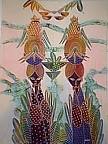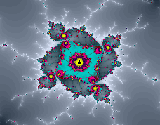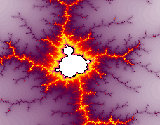|
This
page contains links to articles and documents
authored by project members, to software programs
and components developed by the project, and to other tools
we've found useful and collected here for your convenience.
Each
entry has a title, a summary, a list of authors, a date of publication
or when it was last updated, a distribution designation,
and links to the material in various formats. Each
entry also has its bookmark noted, to help authors making links to it
from other web pages.
Introductory
Notes
For
a fresh introduction to this archive of pattern science, let us take a
look at the following which are from Douglas R. Hofstadter, Metamagical
Themas: Questing for the Essence of Mind and Pattern, 1985.
-
"When you are not looking at it, this sentence is in Spanish."
-
"What would this sentence be like if it were not self- referential?"
-
"If the subjunctive was no longer used in English, this sentence would
be grammatical."
-
"What is a question that mentions the word 'umbrella' for no apparent
reason?"
-
"You have, of course, just begun reading the sentence that you have just
finished reading."
-
"How come this noun phrase doesn't denote the same thing as this noun
phrase?"
-
"If this sentence had been on the previous page, this very moment would
have occurred approximately 60 seconds ago." "Thus, although any esthetically
programmed computer will be 'merely doing what it was programmed to do',
its behavior will nonetheless often appear idiosyncratic and even inscrutable
to its programmers, reflecting the fact -- well known to programmers --
that often one has no clear idea (and sometimes no idea at all) just what
it is that one has programmed the machine to do!" --- Douglas R. Hofstadter,
Metamagical Themas: Questing for the Essence of Mind and Pattern,
1985, page 283.
-
"Will your answer to this particular question be 'no'?" --- Douglas R.
Hofstadter, Metamagical Themas: Questing for the Essence of Mind and
Pattern, 1985, page 487.
-
"Hofstadter's Law: It always takes longer than you expect, even when you
take into account Hofstadter's Law." --- Douglas R. Hofstadter, Go"del,
Escher, Bach: An Eternal Golden Braid, 1980
Surprised?
Just read on this archive, and you will find how interesting the pattern
science is.


Articles
We've
attempted to collect some articles related to the science of patterns
which you might find interesting. You could also contribute to this few
list, or send your comments about these. Soon we might also publish articles
about patterns by our members.
As
you might see in these articles, the science of pattern covers a broad
range of subjects including software programming, textile design, education,
astrophysics, environmental issues, urban spatial design, and even the
foundation of mathematics itself. Even some scientists claimed that mathematics
is about finding the simplest generalisation, thus it is the science
of patterns.
a.
Design Pattern
Design Pattern is a much-hyped about topic in software engineering.
There is a wealth amount of paper and books being published on this
subject. If you havenít heard about Design Pattern this report will
give basic understanding of what it is, how it come about and why and
when we should use it.
b.
Fashion
Pattern Design Software with CAD/CAM
Pattern
Design Software -- Your own unique ideas become a reality with subtle
curve shapes with no rigid "computer type constraints" to your pattern
design.
c.
Fluid Concepts and Creative
Analogies
Given
a series of numbers (0,1,2,720!,...), humans can recognize the pattern
and give the 'next item.' In modeling this on a computer in the Seek-Whence
project, breadth first or depth first search is out -- there are infinitely
many possible operators describing patterns. Instead, humans seem to
scan quickly for easily detectable characteristics and then follow the
leads they find -- an initial breadth first survey, lots of small intense
depth first searches locally, another breadth first overview, and so
on.
d.
Mathematics as the science of patterns
Mathematics
is sometimes defined as the science of patterns. What do we mean
by a "pattern"? A mathematical pattern involves regularity. This regularity
may represent itself in shape, direction, orientation, size, or number
relationships, among other things. The key to being a pattern is that
there is some regularity that can be repeated, extended, or built upon.
e.
Pattern
Maker for cross stitch
Pattern
Maker is an easy-to-use computer program for the design of counted cross-stitch
patterns. The program is available in three levels: Machine Embroidery,
Professional and Standard.
f.
Pattern based education
AIMS
Plans Pattern-Based Math/Science Education.
g.
Seattle
Textile Computer Users Group Resource Guide Pattern
Pattern
Drafting and Clothing Design - Computer Related.
h.
Sew
by Design Workshops
It's
so easy to design beautiful, exciting clothes from basic patterns. Come
to a sew by design workshop and learn how!
i.
Strange Loop
In
the page entitled "Reality is not substance but pattern," I finished
by introducing the recursive definition, "Reality at any given level
of organisation is the pattern into which the underlying level of organisation
is configured," and observed that this definition was incomplete without
the concept of strange loops.
j.
Patterns, chaos, and primes
No
comment is necessary for this stunning and imaginative article.
k.
Partition
Based Point Pattern Analysis Methods for Investigation of Spatial Structure
of Various Stellar Populations
A
primary piece of information on pointlike astronomical objects is their
location. Essential operations, like identification of physical stellar
systems and their members, are based on this information, which often
makes the application of statistical methodology necessary. Application
of various raster and quadtree data representation based methods, furthermore
the Voronoi model for the investigation of point patterns are
presented.

Example
of Mandelbrot set

Introduction
to Pattern Technology
The
initial design document for the core component of the project's software.
Now obsolete, but useful for historical purposes.
By: ALastName, BLastName, and CLastName
Date: March 17, 1999
Distribution: Internal
Formats: .ps (1,480 k), .doc (128 k), HTML
Bookmark: Pattern Design Technology
The
art of batik painting
An
Up-to-date introductory course of the art of batik painting. This
document is always kept in sync with appropriate software.
By: BLastName
Last updated: August 9, 1999
Distribution: Internal
Formats: HTML
Bookmark: XYZspec
How
to add new users to the pattern design group
Instructions
for establishing new user accounts, setting the appropriate permissions
on the file server, and propagating changes to all project member machines.
By: ALastName
Date: June 23, 1999
Distribution: Internal
Formats: HTML
Bookmark: HowToAddUsers

Prototype
for Indonesia antique pattern gallery
Project
output for Q1 deliverable.
By: Project
Date: March 17, 1999
Distribution: Internal
Formats: .zip (628 k)
Bookmark: FeasibilityPrototype

PKZIP
File
compression and decompression utilities for creating archives under
Windows.
By: PKWare
Date: March 17, 1997
Distribution: External, Shareware
Formats: .exe (725 k)
Bookmark: PKZIP

- Internal
- May
only be viewed by people inside the company.
- External
- May
be viewed by people outside the company.
- Published
- Has
already appeared in an external publication.

HTML web page (HyperText Markup Language)
.ps PostScript
.doc Microsoft Word
.rtf Rich Text
.zip archive file for Windows
.tar archive file for UNIX

Another
Mandelbrot set
|

![]()